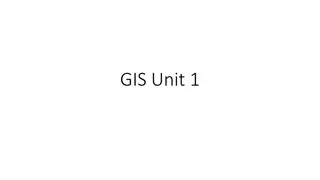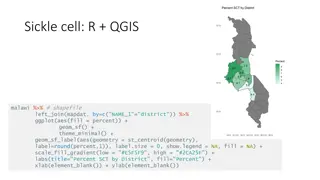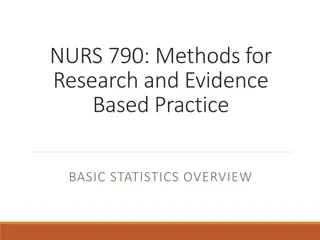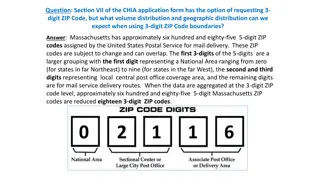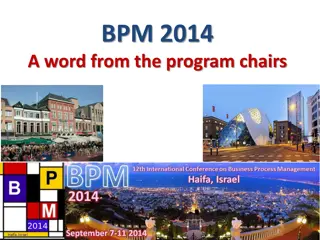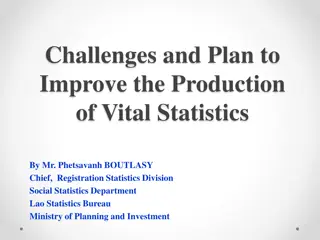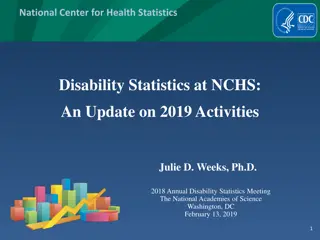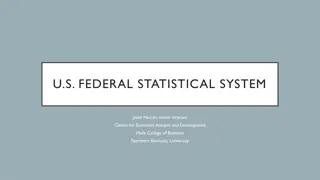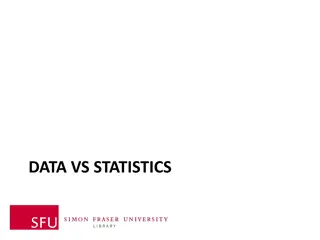Geographic Data Analysis in Health Statistics Conference
The 2010 National Conference on Health Statistics explored the use of restricted data at the National Center for Health Statistics Research Data Center. The presentation delved into the types of data requested, including small geographic areas, sensitive information, mortality files, and genetic data. It also discussed the challenges with using state-level data and proposed using division data for more detailed analysis without violating confidentiality. Maps and tables illustrated the US Census regions and divisions, highlighting the states in each region for better understanding and analysis.
Download Presentation

Please find below an Image/Link to download the presentation.
The content on the website is provided AS IS for your information and personal use only. It may not be sold, licensed, or shared on other websites without obtaining consent from the author.If you encounter any issues during the download, it is possible that the publisher has removed the file from their server.
You are allowed to download the files provided on this website for personal or commercial use, subject to the condition that they are used lawfully. All files are the property of their respective owners.
The content on the website is provided AS IS for your information and personal use only. It may not be sold, licensed, or shared on other websites without obtaining consent from the author.
E N D
Presentation Transcript
2010 National Conference on Health Statistics Exploring NHIS Data by Census Division Deborah Rose Ph.D. National Center for Health Statistics Research Data Center August 16, 2010 Omni Shoreham Hotel, Washington, DC
The previous presentations have covered some of the formal aspects of the NCHS RDC. This presentation is more exploratory, to help you think about what YOU can do with restricted data at the RDC.
Restricted Data at the NCHS/RDC Frequently requested types of data include: Small geographic areas Sensitive information Mortality and linked mortality files Exact dates Small race/ethnicity groups Genetic data
Restricted Geographic Data Frequently used geographic areas include: State County Census tract
Geographic Data in the National Health Interview Survey (NHIS) The sampling frame for the NHIS allows public use estimates to be made for: The whole United States The four Census Regions State is a restricted variable, and: State is not a level in the NHIS sample frame Some states are not included in the sample Some states are too small for stable estimates Using state in analysis may violate confidentiality
A Methodological Research Question What can we use when Region is too large, and State is too small? Division may allow for finer detail than Region, without violating confidentiality.
Map of US Census Regions and Divisions MIDWEST West East North Central North Central W Source: Dept. of Energy, Regional Energy Profiles.
Census Divisions US Census Region US Census Division States Region 1: Northeast 1. New England CT, ME, MA, NH, RI, VT 2. Middle Atlantic NY, NJ, PA Region 2: Midwest 3. East North Central IN, IL, MI, OH, WI 4. West North Central IA, KS, MN, MO, NE, ND, SD Region 3: South 5. South Atlantic DE, MD, WV, DC, VA, NC, SC, GA, FL 6. East South Central MS , AL, TN, KY 7. West South Central TX, OK, AR, LA Region 4: West 8. Mountain MT, ID, WY, NV, UT, CO, AZ,NM 9. Pacific CA, OR, WA, AK, HI Source: US Census Bureau
Goal To compare the use of Region with Division to review the prevalence of selected covariates and five chronic disease conditions.
Overview of the National Health Interview Survey National Health Interview Survey (NHIS) Fielded each year Personal interview, in the home 30-40,000 households 75-100,000 people A multi-stage random sample Represents the civilian, non-institutionalized US population Region is the smallest public use geographic unit Source: NHIS website
Notes Estimates were calculated from the 2009 NHIS Sample Adult file, using the Sample Adult weight. Estimates by Division are not representative of the US population because Division is not part of the NHIS sampling frame. This work is exploratory. Relationships have not been tested for statistical significance.
Demographic and smoking variables Sex Race/ethnicity Cigarette smoking status Current smoking
Percent Male and Female by Region Male Female 54 52 50 48 46 44 42 Northeast Midwest South West Source: 2009 NHIS
Percent Male and Female by Division Male Female 60 50 40 30 20 10 0 Source: 2009 NHIS
Smoking Status by Region Current Former Never 70 60 50 40 30 20 10 0 Northeast Midwest South West Source: 2009 NHIS
Smoking Status by Division Current Former Never 70 60 50 40 30 20 10 0 Source: 2009 NHIS
Prevalence of Current Smoking by Region 25 20 15 10 5 0 Northeast Region Midwest Region South Region West Region Source: 2009 NHIS
Prevalence of Current Smoking by Division 30 25 20 15 10 5 0 Source: 2009 NHIS
Prevalence of Current Smoking by Region and Division Current Smoking 30 25 20 15 10 5 0 Source: 2009 NHIS
Percentage of the Division Population by Race/Ethnicity Group White Black Hispanic Asian Other 90 80 70 60 50 40 30 20 10 0 Source: 2009 NHIS
The Percentage of a Race/Ethnicity Group in Each Division White Black Hispanic Asian Other 45 40 35 30 25 20 15 10 5 0 Source: 2009 NHIS
Selected conditions from the 2009 NHIS Core Questionnaire Have you EVER been told by a doctor or other health professional that you had: . . . Coronary heart disease . . . Hypertension . . . A stroke . . . Diabetes . . . Asthma
Prevalence of Coronary Heart Disease (CHD) by Region 6 5 4 3 2 1 0 Northeast Region Midwest Region South Region West Region Source: 2009 NHIS
Prevalence of CHD by Division Coronary Heart Disease 6 5 4 3 2 1 0 Source: 2009 NHIS
Prevalence of CHD by Region and Division Coronary Heart Disease 6 5 4 3 2 1 0 Source: 2009 NHIS
Prevalence of Hypertension by Region 35 30 25 20 15 10 5 0 Northeast Region Midwest Region South Region West Region Source: 2009 NHIS
Prevalence of Hypertension by Division Hypertension 40 35 30 25 20 15 10 5 0 Source: 2009 NHIS
Prevalence of Hypertension by Region and Division Hypertension 40 35 30 25 20 15 10 5 0 Source: 2009 NHIS
Prevalence of Stroke by Region 3.5 3 2.5 2 1.5 1 0.5 0 Northeast Region Midwest Region South Region West Region Source: 2009 NHIS
Prevalence of Stroke by Division Stroke 6 5 4 3 2 1 0 Source: 2009 NHIS
Prevalence of Stroke by Region and Division Stroke 6 5 4 3 2 1 0 Source: 2009 NHIS
Stroke Belt An area in the southeast part of the United States with a high prevalence of stroke. The East South Central Division is in the stroke belt.
Prevalence of Diabetes by Region 12 10 8 6 4 2 0 Northeast Region Midwest Region South Region West Region Source: 2009 NHIS
Prevalence of Diabetes by Division Diabetes 12 10 8 6 4 2 0 Source: 2009 NHIS
Prevalence of Diabetes by Region and Division Diabetes 12 10 8 6 4 2 0 Source: 2009 NHIS
Prevalence of Asthma by Region 14 13.5 13 12.5 12 11.5 Northeast Region Midwest Region South Region West Region Source: 2009 NHIS
Prevalence of Asthma by Division Asthma 14.5 14 13.5 13 12.5 12 11.5 11 Source: 2009 NHIS
Prevalence of Asthma by Region and Division Asthma 14.5 14 13.5 13 12.5 12 11.5 11 Source: 2009 NHIS
Five Conditions by Region Hypertension CHD Stroke Asthma Diabetes 35 30 25 20 15 10 5 0 Northeast Midwest South West Source: 2009 NHIS
Five Conditions by Division Hypertension CHD Stroke Asthma Diabetes 40 35 30 25 20 15 10 5 0 Source: 2009 NHIS
Summary and Conclusions Displaying chronic conditions and covariates by Division can reveal more detail than showing them by Region.
Reaching the RDC from the NCHS Homepage
Or, go directly to the NCHS/RDC home page: http://www.cdc.gov/rdc
To learn more about the geocode data available at the NCHS / RDC: Click on Step 1: Types of Data On the next page, pick Restricted Data Click on Geocodes by NCHS Survey We look forward to seeing you soon!




